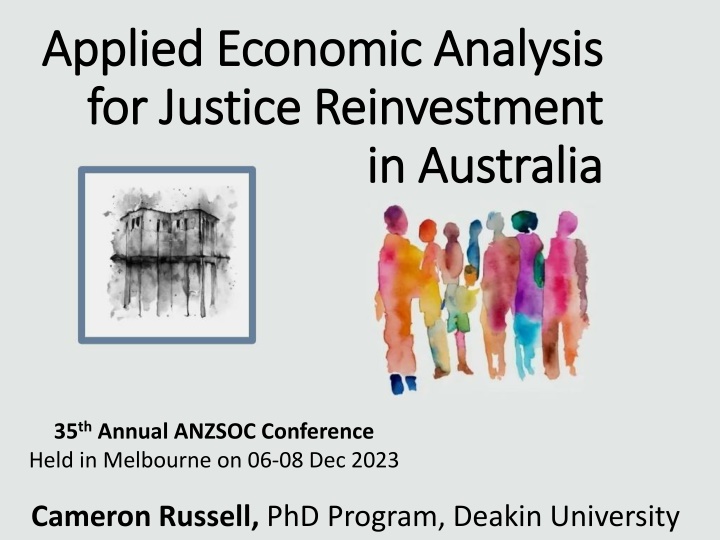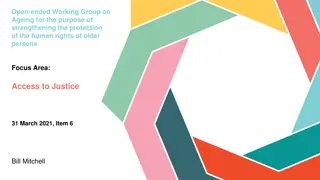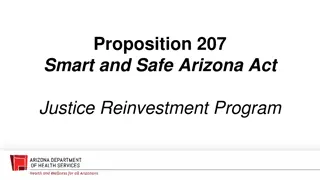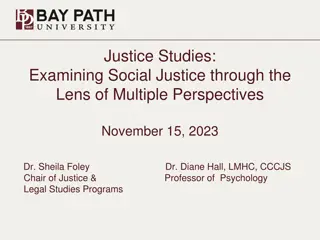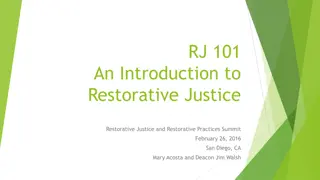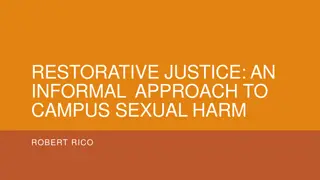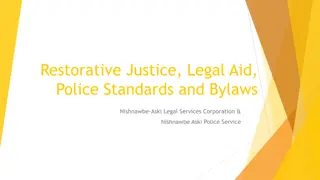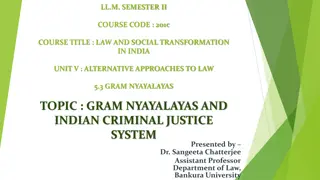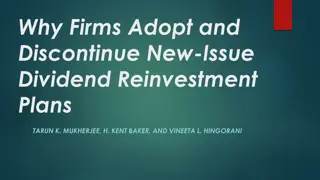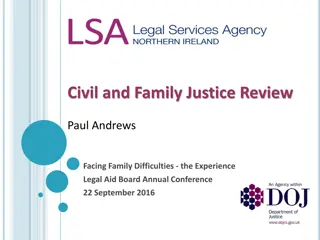Addressing the Challenges of Justice Reinvestment in Australia
In Australia, the escalating incarceration rate, especially among vulnerable populations like First Nations people and those with disabilities, poses a significant societal issue. The financial burden of incarceration is staggering, with costs reaching $6.1 billion annually. This highlights the urgent need for effective justice reinvestment strategies to address the root causes and prevent further prison expansion.
Download Presentation

Please find below an Image/Link to download the presentation.
The content on the website is provided AS IS for your information and personal use only. It may not be sold, licensed, or shared on other websites without obtaining consent from the author.If you encounter any issues during the download, it is possible that the publisher has removed the file from their server.
You are allowed to download the files provided on this website for personal or commercial use, subject to the condition that they are used lawfully. All files are the property of their respective owners.
The content on the website is provided AS IS for your information and personal use only. It may not be sold, licensed, or shared on other websites without obtaining consent from the author.
E N D
Presentation Transcript
Applied Applied Economic Economic Analysis for for Justice Justice Reinvestment Reinvestment Analysis in Australia in Australia 35th Annual ANZSOC Conference Held in Melbourne on 06-08 Dec 2023 Cameron Russell, PhD Program, Deakin University
Supervisors Dr Clare Farmer, Associate Professor (Criminology), Deakin University Dr Romain Gauriot, Senior Lecturer (Economics), Deakin University Dr Stuart Kinner, Professor (Health Equity), Curtin University
Acknowledgement of Country I acknowledge and pay my respects to past, present and emerging Elders and Custodians of the land on which we meet, the Wurundjeri Woi Wurrung and Bunurong peoples of the Kulin Nation. Their stolen lands have never been ceded.
Australia has a problem Incarceration rate: 206/100k [1]
The prison spiral People in prison are some of the most vulnerable people in society and often come from disadvantaged backgrounds [9,10]
Especially a problem for First Nations people: Incarceration rate of 2,470 per 100,000 [1] (world s highest [2]) 32% of prison population [3] yet only 3.8% of Australian pop. [4] Young First Nations people 56% of youth detention population yet only 6% of Australian pop. [5]
Especially a problem for People with disabilities: 50% prison entrants have reported disabilities (cf. 18%) [6] Bullied & assaulted [7] Shortage of forensic hospital beds so prison instead [8,9] Sick and other vulnerable people more likely to be jailed and return to prison [10]
Cost of incarceration $6.1 billion per year for prisons [11,12] Ave cost/inmate: $405/day or $148k/yr Unsustainable: An increase of $2 billion in just 5 years! Most prisons full, so more prisoners means building more prisons
Indirect costs of incarceration Negative effects on inmate s family, community, health, housing, job, education, etc Upon release, hard to get housing, job, transport, etc and dangers of substance misuse Lack of a job/lower wages/lost skills mean higher costs for employment programs [10,11]
Prisons are ineffective Prisons are ineffective at reforming those held [17] Better alternatives for non-violent offenders incl. community-based orders/drug court The worst offence of 38% of prisoners was a non-violent offence, and $2.3 billion was spent to jail them [11,12] Tough-on-crime populism results in unnecessary imprisonment
Prisons are ineffective Prison deepens vulnerabilities [14,15,16] E.g. Human Rights Watch investigated 14 Australian prisons and found inmates with disabilities were subjected to regular bullying, violence and solitary confinement, with devastating effects to their mental health [7]
Reversing the prison spiral Need sustained, coordinated response by all stakeholders Aim: Eliminate disadvantage [10,13] Can also be prison reform, restorative justice, transformative justice, community policing & abolition of police/prisons [11]
Justice Reinvestment Definition: Justice Reinvestment = redirecting funds from prisons/police to vulnerable communities with the purpose of reducing crime, the need for law enforcement & incarceration (savings are reinvested in further community-based initiatives)
JIRAD = JI + JR + JD JIRAD = Justice Investment, Reinvestment and/or Diversion
The rationale JIRAD implementation in Australia: Limited evidence on what works [18] Main objective of research: To contribute to JIRAD applied economic modelling as a foundation for evidence-based JIRAD policymaking and decision- making
JIRAD initiatives Each JIRAD initiative is different, with variations in: Locality The people involved: Stakeholders, beneficiaries, decision-makers Investment/reinvestment amounts Initiative purpose and design Savings and other benefits Investment, reinvestment and/or diversion Investment before, during and/or after prison
Main thrust of research Economic analysis of past and present JIRAD initiatives (mainly in Australia, the UK (England & Wales jurisdictions) & the USA Tangible and intangible returns on investment/reinvestment How effective various JIRAD initiatives/strategies are in diversion Improved ability to predict returns
Other strands of research Interviewing community members/JIRAD experts Primary hypothesis: For optimal outcomes in the long-term, all three JIRAD activities (investment, reinvestment and diversion) will need to be implemented at the appropriate times Secondary hypothesis: Reforms of the criminal justice system bring the greatest and most widespread benefits in the shortest possible time at the lowest possible cost, although JIRAD in poorer and more vulnerable communities is essential for medium and long-term improvement
Key research question 1 1. What are the tangible & intangible benefits of the JIRAD initiative? (Focus: Cost-benefit analyses broader & more comprehensive than ROI below)
Key research question 2 In given circumstances & location, which JIRAD initiative is likely to be the most effective in diversion, crime prevention, savings & other benefits? (Focus: Comparing JIRAD strategies for effectiveness in delivering positive outcomes for vulnerable people and their communities)
Key research question 3 What tangible and intangible savings and other benefits (if any) may be expected following the implementation of a particular JIRAD initiative in given circumstances and a given Australian location? (Focus: ROI for completed JIRAD initiative)
The 4 stages to JIRAD 1. Justice mapping of public spending in disadvantaged regions 2.Providing options to policymakers 3.Analysis, development and implementation of JIRAD policies 4.Measurement and evaluation [19]
Question: Whats missing? 1. Justice mapping of public spending in disadvantaged regions 2.Providing options to policymakers 3.Analysis, development and implementation of JIRAD policies 4.Measurement and evaluation
One answer Those most affected and their community! The voice of those most impacted by prisons and policing Their leadership, design & involvement
The upward spiral
Voice for the voiceless The people most traumatised by law enforcement are the people least heard in society For there to be change, their voices must be amplified and become pivotal
Who do we listen to? Real ownership by those most impacted by law enforcement, and their community They decide: Who is involved Desired outcomes Design and process Investment Timing Method of review
Example 1: Data sovereignty The required data before, during and after each JIRAD initiative comes from the community and belongs to the community It is not the preserve of governments and universities
Example 2: Who benefits? Not just the govt & taxpayer To bring change, positive outcomes must primarily be for vulnerable communities
Example 3: Who is investing? Not just the govt Mainly the community: Donations Time Mental effort Leadership & design Trust Risk
Conclusion JIRAD holds great promise for those harmed by the criminal justice system for governments facing massive incarceration and law enforcement costs Australia has been slow in implementing JIRAD, partly due to a lack of data Expanded economic analysis and modelling of JIRAD initiatives in the Australian context can only help
References (1) 1. Australian Bureau of Statistics (Jun-quarter- 2023), Corrective Services, Australia, ABS Website. 2. Anthony, T., 2017. Factcheck: Are first Australians the most imprisoned people on Earth? The Conversation. 3. Australian Bureau of Statistics (2022), Prisoners in Australia, Table 1, ABS Website. 4. Australian Institute of Health and Welfare (07 Sep 2023), Profile of First Nations people. 5. Australian Institute of Health and Welfare (13 Dec 2022), Youth detention population in Australia 2022. 6. Disability Royal Commission, Public Hearing 27, Transcript Day 1, p. 11. 7. Sharma K (2023). Australians with disabilities face pervasive abuse: Royal Commission issues highly critical report after 4-year inquiry. Human Rights Watch.
References (2) 8. Morris P (26 April 2022). The Australian mental health crisis: A system failure in need of treatment. Submission to Mental Health Select Committee by the National Association of Practising Psychiatrists. 9. Australian Institute of Health and Welfare (2022). Health of Prisoners. 10. Tanton R, et al. (2021). Dropping off the edge 2021: Persistent and multilayered disadvantage in Australia. Melbourne: Jesuit Social Services. 11. Productivity Commission (2021). Australia s prison dilemma: Research paper. Australian Government 12. Schlicht M (2023). The cost of prisons in Australia: 2023. Institute of Public Affairs.
References (3) 13. Baldry E, et al. (2018). A future beyond the wall: Improving post-release employment outcomes for people leaving prison final report, UNSW, Sydney, doi:10.26190/5B4FD2DE5CFB4 14. Dowse L, Rowe S, Baldry E and Baker M (2021) Research Report: Police responses to people with disability, Submission to Royal Commission into Violence, Abuse, Neglect and Exploitation of People with Disability. 15. Young R (11 April 2022) Mohamad Alameddine s bid to change bail conditions rejected, Perth Now. 16. Hunter F (24 February 2021) Hamzy brother arrested for alleged breach of crime prevention order, Sydney Morning Herald.
References (4) 17.Grimsrud T and Zehr H (2002) Rethinking God, justice, and treatment of offenders, in O Connor TP and Pallone NJ (eds) (2002) Religion, the community, and the rehabilitation of criminal offenders, Haworth Press, New York. 18.Willis M and Kapira M (2018) Justice reinvestment in Australia: A review of the literature. Research Report 09, Australian Institute of Criminology, Canberra. 19.Fox C and Albertson K (2010) Could economics solve the prison crisis? Probation Journal57(3), 263 280.
Thank you Cameron Russell aprj.com.au
